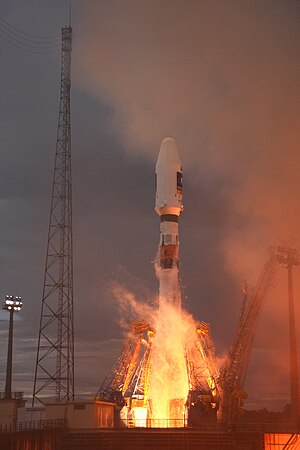Soyuz Flight VS09

Inaugural launch
|
|
| Function | Provide Arianespace with a medium-class launch vehicle to compliment the light Vega and heavy Ariane 5 |
|---|---|
| Manufacturer | Progress State Research and Production Rocket Space Center, NPO Lavochkin |
| Country of origin | Russia |
| Size | |
| Height | 46.2 m (152 ft) |
| Diameter | 10.3 m (34 ft) |
| Mass | 308 t (303 long tons; 340 short tons) |
| Stages | 3 |
| Capacity | |
| Payload to GTO | 3,250 kg (7,170 lb) |
| Payload to GEO | 1,440 kg (3,170 lb) |
| Payload to SSO | 4,400 kg (9,700 lb) |
| Associated rockets | |
| Family | Soyuz 2 (R-7) |
| Launch history | |
| Status | Active |
| Launch sites | Guiana Space Centre |
| Total launches | 17 |
| Successes | 16 |
| Failures | 0 |
| Partial failures | 1 |
| First flight | 21 October 2011 |
| Boosters | |
| No. boosters | 4 |
| Length | 19.6 m (64 ft) |
| Diameter | 2.68 m (8 ft 10 in) |
| Empty mass | 3,784 kg (8,342 lb) |
| Gross mass | 44,413 kg (97,914 lb) |
| Engines | 1 RD-107A |
| Thrust | 838.5 kN (188,500 lbf) |
| Specific impulse | 262s |
| Burn time | 118s |
| Fuel | LOX / Kerosene |
| Core stage | |
| Length | 27.1 m (89 ft) |
| Diameter | 2.95 m (9 ft 8 in) |
| Empty mass | 6,545 kg (14,429 lb) |
| Gross mass | 99,765 kg (219,944 lb) |
| Engines | 1 RD-108A |
| Thrust | 792.5 kN (178,200 lbf) |
| Specific impulse | 255s |
| Burn time | 286s |
| Fuel | LOX / Kerosene |
| Second stage (ST-B) | |
| Length | 6.7 m (22 ft) |
| Diameter | 2.66 m (8 ft 9 in) |
| Empty mass | 2,355 kg (5,192 lb) |
| Gross mass | 27,755 kg (61,189 lb) |
| Engines | 1 RD-0124 |
| Thrust | 297.9 kN (67,000 lbf) |
| Specific impulse | 359s |
| Burn time | 270s |
| Fuel | LOX / Kerosene |
| Upper stage - Fregat | |
| Length | 1.5 m (4 ft 11 in) |
| Diameter | 3.35 m (11.0 ft) |
| Empty mass | 920 kg (2,030 lb) |
| Gross mass | 7,558 kg (16,663 lb) |
| Engines | S5.92 |
| Thrust | 19.85 kN (4,460 lbf) / 14 kN (3,100 lbf) |
| Specific impulse | 332s |
| Burn time | up to 1100s (maximum 20 burns) |
| Fuel | N2O4 / UDMH |
Soyuz at the Guiana Space Centre (also known as Soyuz at CSG or Arianespace Soyuz) is an ongoing ESA programme for operating Soyuz-ST launch vehicles from Guiana Space Centre (CSG), providing medium-size launch capability for Arianespace to accompany the light Vega and heavy-lift Ariane 5. The Soyuz vehicle is supplied by the Russian Federal Space Agency with TsSKB-Progress and NPO Lavochkin, while additional components are supplied by EADS, Thales Group and RUAG.
The Arianespace Soyuz project was announced by the ESA in 2002. Cooperation with Russia began in two areas: construction of a launch site for Soyuz in CSG and development of the Soyuz launch vehicle modified for the Guiana Space Centre. A Programme Declaration was signed in 2003 and funding along with final approval was granted on 4 February 2005. Initial excavation for the Ensemble de Lancement Soyouz (ELS; Soyuz Launch Complex) began in 2005, construction started in 2007, and the launch complex was completed in early 2011, allowing Arianespace to offer launch services on the modified Soyuz ST-B to its clients. Two early flights, VS02 and VS04, used the Soyuz ST-A variant. Since 2011, Arianespace has ordered a total of 23 Soyuz rockets, enough to cover its needs until 2019 at a pace of three to four launches per year.
Soyuz components arrive at the CSG via ship, and are unloaded and placed in a storage area. From there, the components are brought to the Launch Vehicle Integration Building where they're assembled horizontally in an air-conditioned environment. First four boosters are attached to the core stage, and then third stage is attached to the core – identical to the procedure at Baikonur and Plesetsk Cosmodrome. Separately, the payload is mounted on a dispenser in a Payload Processing Facility and then transferred into the S3B building to be mounted to the Fregat upper stage and then encapsulated in a fairing. Subsequently, the first 3 stages of the Soyuz-ST are transported from the Integration Building to the launch pad by a train which also erects the rocket to the vertical position at the pad, where Soyuz is suspended by four support arms. Once vertical, a mobile gantry moves in and encloses Soyuz. Following that the encapsulated Fregat and payload is lifted vertically by a mobile gantry to be mounted on top of Soyuz. The Mobile Gantry is retracted an hour before the launch.
...
Wikipedia
